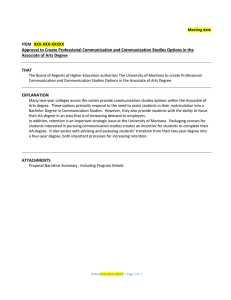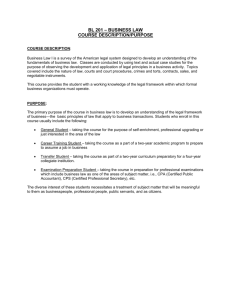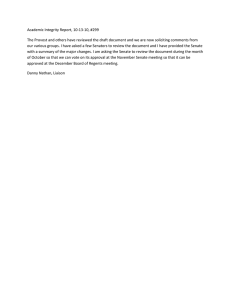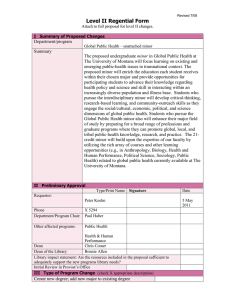Members Present: B. Allen, L. Ametsbichler, L. Barnes, D. Beck, M. Bowman... J. Carter, J. Crepeau, W. Davies, J. DeBoer, A. Delaney,...
advertisement
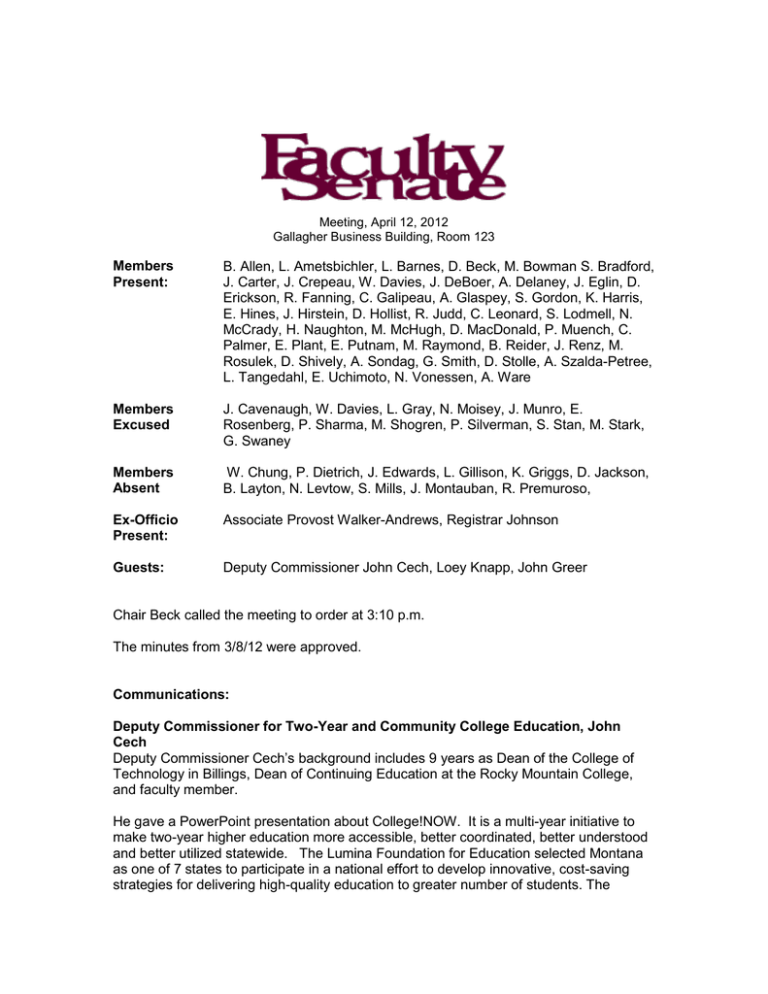
Meeting, April 12, 2012 Gallagher Business Building, Room 123 Members Present: B. Allen, L. Ametsbichler, L. Barnes, D. Beck, M. Bowman S. Bradford, J. Carter, J. Crepeau, W. Davies, J. DeBoer, A. Delaney, J. Eglin, D. Erickson, R. Fanning, C. Galipeau, A. Glaspey, S. Gordon, K. Harris, E. Hines, J. Hirstein, D. Hollist, R. Judd, C. Leonard, S. Lodmell, N. McCrady, H. Naughton, M. McHugh, D. MacDonald, P. Muench, C. Palmer, E. Plant, E. Putnam, M. Raymond, B. Reider, J. Renz, M. Rosulek, D. Shively, A. Sondag, G. Smith, D. Stolle, A. Szalda-Petree, L. Tangedahl, E. Uchimoto, N. Vonessen, A. Ware Members Excused J. Cavenaugh, W. Davies, L. Gray, N. Moisey, J. Munro, E. Rosenberg, P. Sharma, M. Shogren, P. Silverman, S. Stan, M. Stark, G. Swaney Members Absent W. Chung, P. Dietrich, J. Edwards, L. Gillison, K. Griggs, D. Jackson, B. Layton, N. Levtow, S. Mills, J. Montauban, R. Premuroso, Ex-Officio Present: Associate Provost Walker-Andrews, Registrar Johnson Guests: Deputy Commissioner John Cech, Loey Knapp, John Greer Chair Beck called the meeting to order at 3:10 p.m. The minutes from 3/8/12 were approved. Communications: Deputy Commissioner for Two-Year and Community College Education, John Cech Deputy Commissioner Cech’s background includes 9 years as Dean of the College of Technology in Billings, Dean of Continuing Education at the Rocky Mountain College, and faculty member. He gave a PowerPoint presentation about College!NOW. It is a multi-year initiative to make two-year higher education more accessible, better coordinated, better understood and better utilized statewide. The Lumina Foundation for Education selected Montana as one of 7 states to participate in a national effort to develop innovative, cost-saving strategies for delivering high-quality education to greater number of students. The demand for an educated workforce continues to grow. Montana has a low percentage rate of students attending 2-year institutions (27% compared to the national average of 53%). Montana needs to improve opportunities for two-year education due to the aging population (4th oldest state), traditional high school student population is decreasing, and current educational attainment rates will not enable the state to meet future demands. According to the Department of Labor Montana’s projected degree gap is 13.5%. The comprehensive Two-Year Mission Statement approved by the Board of Regents May 2011 is: To provide a comprehensive, accessible, responsible, student-centered learning environment that facilitates and supports the achievement of individuals’ professional and personal goals and enhances the development of Montana’s citizens, communities, and economy. The two-year mission components include: 1. 2. 3. 4. 5. Transfer Education Through Associates Degree Workforce Development, Including Certificates and Applied Associate’s Degrees Developmental and Adult Basic Education Lifelong Learning Community Development Core Values of the MUS Two-Year Education are excellence, rigor, and relevance, diversity, civic engagement, innovation, integrity, accountability, transparency, inclusivity, consistent unified support, lifelong learning, and student success. The expanded mission will require rebranding. Mission, affiliation and place must be considered in renaming and branding the two-year schools. The Office of Commissioner of Higher Education conducted brand market research. It held listening sessions with student focus groups and sent surveys to students and the community to identify a preferred name. The results indicate that the name should first include place, second mission, and third affiliation. Several examples of other two-year colleges were provided. Questions/Concerns: There seems to be a mixed message with regard to whether the College of Technology is a College within the University of Montana or a separate institution. The College!Now initiative is not designed to change the organizational structure. The relationship of the two-year schools with the four-year schools should be beneficial. The two-year schools should be an integral part of the four-year schools. The use of Missoula in the title would be very confusing. The sample of Missoula College does not communicate the mission of the institution. The term “Community” will likely not be in the title because it is tied to a statute of creating a district and would require a vote. Five Valleys College is among the names recommended. Currently two-year funding is included in the lump sum that is distributed to the two sides of the system. There may be opportunities with the Legislature to move funding. One exception to the funding structure is the mill levy that is intended to fund Flathead Valley Community College. The two-year colleges are the fastest growing units in the system. The Regents are interested in improving the image to increase the value of education. The two-year colleges attract different students than the Universities so should complement not compete. The association of the two-year colleges with the Universities should strengthen the system not weaken it. The colleges offer an alternative way to reach out to the community. One exception to the funding structure is the mill levy ($1.5 million) intended to fund Flathead Valley Community College. Senator Crepeau, President of the College of Technology Faculty Association Teachers Union: Section 7.100 of the contract (same as UFA’s contract) has not been honored in terms of naming conventions. It was not done maliciously. However, the COT faculty feel strongly that the name should reflect what the college does, similar to the other colleges at UM. The College of Technology has a different delivery model (smaller sections) than the main campus and serves a different group of students. Data collection and marketing would have been helpful in the College of Education and Human Services recent name change. Associate Provost Arlene Walker-Andrews The Graduation Lists were approved. There was concern that the motion should not come from ex-officio members of the Senate. [Note: After the meeting Chair Beck referenced the by-laws and Robert’s Rules. The Associate Provost is an ex-officio member and has the right to bring a motion.] Interim Chief Information Technology Officer, Loey Knapp The Information Technology Strategic Plan was introduced briefly. The Plan is available at: http://umt.edu/it/strategicplan/ and includes a feedback link. Comments will also be available on the site for transparency. The Planning Team has been working for eight months to address questions of efficiencies, mission, and governance. Last week three consultants (Dr. Polley McClure, Vice President, Emeritus, Cornell University; Mr. Bruce Maas, CIO, University of Wisconsin- Madison; and Mr. Boldemar Innus, Interim Vice President, Finance and Management, SUNY- Buffalo) visited campus and provided valuable input. The plan consists of five strategic areas: 1. 2. 3. 4. Information Technology Infrastructure IT Enterprise: Structure, Governance and Funding IT for Teaching, Learning, and Research IT for Institutional Administration, Decision Making, and Innovation 5. IT to Enhance Student Life There currently is no mechanism for collaborative decision making and the academic and student affairs voice seem to be missing in the process. At this point the Planning Team is looking for feedback. Your comments will be taken into consideration in revising the plan with specific recommendations. There should be an institutionalized process for moving initiatives forward and prioritization. One consideration is the estimated cost ($500,000) of campus-wide wireless. Chair’s Report: Prerequisite Pilot Update The expansion of prerequisite enforcement was postponed for one semester. A message sent by the Provost was posted to the agenda. Evaluation of the Administration The evaluation response percentages and ranking of overall effectiveness (0-5) were shared with the Senate. The details of the evaluation are confidential because they deal with personnel issues. In this case, ECOS and the Senate can be considered similar to a Faculty Evaluation Committee. The full report is available in the Senate Office for review by senators. The President and Provost have agreed to consider the results in their performance review of the administrators they supervise. This is the first year of the new procedure which requires the President and Provost to provide ECOS with an update of issues identified in the review. Access to the information is now limited to allow for use in the evaluation process of the administrators in order to give the procedure more meaning. The Provost has already met with one of the Deans as a result of the report’s content. The report was approved in accordance with the procedure. Election results for Senators The results were posted. The new Chair-elect and ECOS members will be elected at the May meeting. There are seven members of the Executive Committee. It meets every Thursday to carry out the detailed business of the Senate. Chair Beck encourages senators to consider the two-year commitment. It has been a very rewarding experience and gives you an idea of ongoing institutional issues. Budget According to the University Budget Committee we can expect some belt tightening over the next couple of years. There is a decline in research funding and a significant decline in student enrollment (down more than 5% from last year). Increased expenditures include the pay plan, $1.7 million for Information Technology infrastructure, and strategic plan initiatives. Chair Beck met with the leadership of Montana State University’s Faculty Senate yesterday. The Montana University System Faculty Association Representatives (MUSFAR) is conducting a poll regarding faculty members’ top three priorities of the Regents’ initiatives. Please respond to the email inquiry with your rankings. They will be provided to the Regents. The students’ top priority is better support for Faculty and Staff. MSU is also concerned about the College!Now initiative as well as the relationship between their main campus and the Gallatin County College of Technology. Committee Reports ASCRC Chair Tangedahl The change to the add/drop date was introduced. It will be voted on next month. The proposed change would change the add deadline in Banner from the 15th instructional day to the 7th instructional day. Students can continue to add with consent of instructor through the 15th day. Executive Director O’Hare presented the change to ASUM yesterday. The students are strongly in favor and it has the full support of the Provost, as well as the Financial Aid and Registrar’s Office. In comparison to peer institutions, UM’s current practice is clearly an outlier. New Business The Center Review documents for the Center of Ethics and Rite Care Speech, Language and Hearing Clinic were approved. Action on the O’Conner Center for the Rocky Mountain West was postponed. The Center is not entirely self-supporting as was promised when originally approved. Because of this, it is on a two-year review cycle. The cost is going down. The full report will be sent to senators for consideration. Action on the document was postponed Good and Welfare Senator Crepeau: The COT Union is working with the UFA and the Commissioner’s Office to assure that all the elements of shared governance are honored in the College!Now initiative. The current UM branding effort is another top-down initiative that faculty should watch. Senators were reminded that it is time to respond to the request for committee service. Please encourage your colleagues to become involved to assure that faculty members have a voice. The Day of Dialog website is up and accepting proposals from faculty, staff, and students. The deadline for submissions is May 25th. The UM Conference for Undergraduate Research Conference is April 13th. The schedule is available online. The meeting was adjourned at 4:45 pm.
